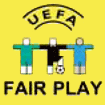UEFA Fair Play Competition
|

|
The UEFA Fair Play Competition, which was introduced in the 1993/94 season gives three countries the chance to enter an additional club in the 1st qualifying round of the Europa League. UEFA maintains a ranking list based on all national and club matches played between May 1 and Apr 30 (in the past this period was June 1 to May 31) in all UEFA competitions except the UEFA Regions Cup.
From 2016 on winners of the UEFA Fair Play competition no longer qualify for the Europa League. Instead the winning associations are being awarded prize money to allocate to fair play or respect-themed projects.
From 2009 on the three places in the UEFA Europa League will automatically go to the three best-placed associations in the ranking, provided they achieve 8 points or more. Before 2009 only the association that topped the ranking automaticly qualified for a UEFA Cup place. All associations which achieved an average of 8 points or more went into a draw to determine the other two places.
The three Europa League places go to the club which won the domestic fair play competition. For this purpose each association maintains a ranking list based on matches in the national league and cup. If the winner already qualified for one of the UEFA competitions the next club on the domestic fair play ranking gets the Europa League place. Before 1999 the 3 Fair Play Cup places were not awarded to specific teams as not each country had it's own Fair Play competition.
| List of qualifiers through the Fair Play Competition |
|---|
|
2015: final ranking (last intermediate ranking)
Go Ahead Eagles, The Netherlands (final ranking) West Ham United, England (final ranking), press article Uni College Dublin, Ireland, press article 2014: final ranking (last intermediate ranking)
2013: final ranking (last intermediate ranking)
2012: final ranking (last intermediate ranking)
2011: final ranking (last intermediate ranking)
2010: ranking
2009: ranking
2008: ranking and draw
2007: ranking and draw.
2006: ranking.
2005: ranking.
2004: ranking
2003: ranking
2002: ranking
2001:
2000: ranking
1999:
1998: England, Finland and Norway 1997: Norway, England and Sweden 1996: Sweden, Russia and Finland 1995: Norway, England and Luxembourg |
The Fair Play coefficient is based on criteria such as positive play, respect for opponents and the referee, the behaviour of team officials and supporters as well as cautions and dismissals. The highest mark that can be awarded is ten points. For each association the assessements of all the matches are added together and then divided by the number of matches. Only associations that played a reasonable amount of matches are considered. This number is determined by dividing the total number of matches of all associations by the number of associations.
The fair play conduct is assessed by the appointed UEFA match delegate. Following the game he has to complete a Fair Play assessement form in consultation with the referee and the referee observer.
On the assessement form are six criteria:
- Red and yellow cards: max 10 points
Deduction from a maximum of 10 points: yellow card = 1 point, red card = 3 points. Two times yellow equals red, but yellow + direct red = 4 points deduction. The total of this aspect may become negative. - Positive play: minimum 1 point, maximum 10 points
Positive aspects: attacking tactics, acceleration of the game, efforts to gain time, and continued pursuit of goals. Negative aspects: deceleration of the game, time-wasting, tactics based on foul-play, play-acting, etc. In general terms positive play correlates with the numer of goal-scoring chances created and the number of goals scored. - Respect of the opponent: minimum 1 point, maximum 5 points
Assessement should be based on positive attitudes (e.g. helping an injured opponent) rather than infringements. Double counting against the item "red and yellow cards" should be avoided. Blameless behaviour, but without any particularly positive attitude, should be assessed with a mark 4 rather than 5. - Respect of the referee: minimum 1 point, maximum 5 points
A positive attitude towards the referee (and assistant referees), including the acceptance of doubtful decisions without protest, should be rewarded. Double counting against the item "red and yellow cards" should be avoided. Normal behaviour, but without any particularly positive attitude, should be assessed with a mark 4 rather than 5. - Behaviour of team officials: minimum 1 point, maximum 5 points
Postive and negative aspects of the behaviour of team officials should be assessed. E.g. whether they calm or provoke angry players or fans, how they accept the referee's decisions, etc. Co-operation with the media should also be considered as a factor. Blameless behaviour, but without any particularly positive attitude, should be assessed with a mark 4 rather than 5. - Behaviour of the crowd: minimum 1 point, maximum 5 points
Encouragement of teams by shouting, singing, etc. may have a positive influence on the atmosphere. The spectators are, however, expected to respect the opposing team and the referee. The should appreciate the performance of the opposition even if they emerge as the winners. The must in no way intimidate or frighten the opposing team, the referee, or opposing supporters. This item is applicable only if a substantial number of fans of the team concerned are present.
More information may be found in Annex 5 of the regulations of the UEFA Cup and wikipedia.
back to the UEFA European Cup Football pages